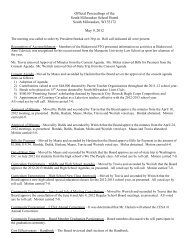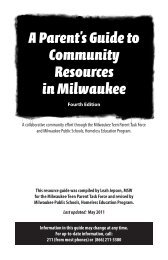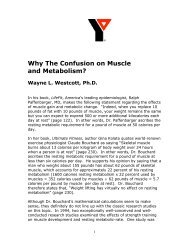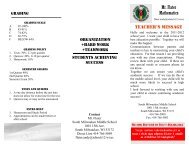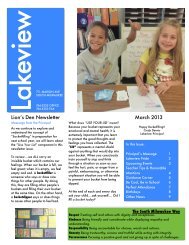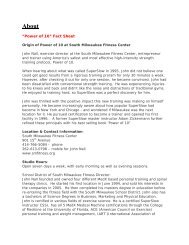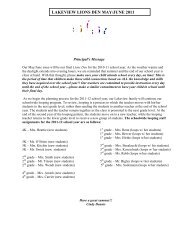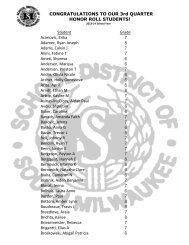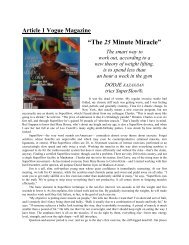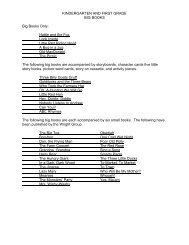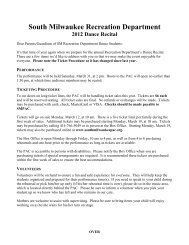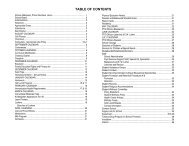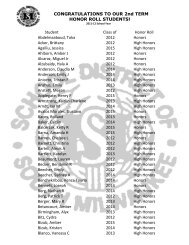High School Student Handbook - South Milwaukee School District
High School Student Handbook - South Milwaukee School District
High School Student Handbook - South Milwaukee School District
Create successful ePaper yourself
Turn your PDF publications into a flip-book with our unique Google optimized e-Paper software.
separately from behaviors of lifelong learners unless the behaviors are part of essential<br />
academic standards. Behaviors of life-long learners are a combination of life-skills that adults<br />
are expected to demonstrate daily including punctual attendance, professional language,<br />
respectful and responsible behavior, active participation, honesty and integrity, and sincere<br />
effort.<br />
The behaviors of lifelong learners are based on the district’s life skills matrix. Six behavior<br />
categories are identified:<br />
• Acquire the Capacity and Motivation for Lifelong Learning. This life-skill deals with assuming<br />
responsibility for personal goal setting, self-motivation, and commitment to personal<br />
improvement.<br />
• Productive worker. This life-skill deals with developing employability skills that will enhance<br />
career opportunities and personal growth.<br />
• Develop Physical and Emotional Wellness. This life-skill deals with making healthy life-style<br />
choices, demonstrating a balance among various areas of responsibility<br />
(social/family/work/school).<br />
• Respects Cultural Diversity and Pluralism. This life-skill deals with showing respect for<br />
diversity and working cooperatively with people of differing backgrounds.<br />
• Citizenship. This life-skill deals with taking an active role in and contributing to the classroom<br />
environment.<br />
• Character. This life-skill deals with showing respect for the rights of self, others, and of<br />
property as well as demonstrating honesty, integrity, and empathy.<br />
Of the six life skills, teachers will holistically assess citizenship, character, and productive<br />
worker traits using the following indicators in class to determine the mark for behaviors:<br />
attendance, log entries for behavior, completion of homework and practice, participation in<br />
class, effort demonstrated, and cooperation in teams. With comments as necessary, teachers<br />
will provide one of the following marks that reflect life-skill behaviors exhibited in class:<br />
• Exceeds Expectations: The student has demonstrated behaviors that strongly align with<br />
life-long learning and preparation for post-high school plans.<br />
• Satisfactory: The student has demonstrated behaviors that align well with life-long learning<br />
and preparation for post-high school plans.<br />
• Needs Improvement: The student has demonstrated behaviors that do not align with lifelong<br />
learning and preparation for post-high school plans.<br />
If a child receives the mark “needs improvement” or “exceeds expectations,” teachers will<br />
provide corresponding comments. Teachers may provide comments with the mark of<br />
satisfactory.<br />
This information will be provided in Powerschool, progress reports, and report cards and can<br />
be used as a tool to guide discussion during parent/teacher conferences.<br />
<strong>Student</strong>s and parents play a critical role in the grading process.<br />
<strong>Student</strong>s’ Role and Responsibilities<br />
• Attend school regularly.<br />
• Complete schoolwork in a thoughtful, timely manner that is reflective of your best effort.<br />
• Prepare for assignments and assessments in order to develop knowledge, skills,<br />
understandings, and work habits.<br />
• Take ownership for the honesty and integrity of all assignments/assessments.<br />
• Respond to feedback in order to further develop knowledge, skills, understandings, and<br />
work habits.<br />
42



